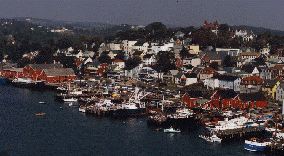LUNENBURG

One of Nova Scotia's most historic and scenic towns, Lunenburg's colourful waterfront, narrow streets and captivating architecture radiate the flavour of the town's seafaring heritage. Settled in 1753 by German, Swiss and Montbeliardian Protestants under British patronage. German was well-spoken in the communities well into the 1800's. Many of today's residents are direct descendants of the first settlers. The early settlers were primarily farmers, but they quickly turned to the sea for their livelihood, building a world-class fishing and shipbuilding industry. At the turn of the century Lunenburg's schooner fleet sailed the Grand Banks, competing with the fleets of New England to bring home the abundance of cod.
Old Town Lunenburg is an outstanding example of British colonial settlement in North America. Dozens of historic buildings and homes dating back to 1760 have been beautifully maintained, and the streets still follow the original town plan of 1754. This extraordinary level of preservation led to the town's being declared a Canadian National Heritage District in 1994, and in 1995 the United Nations bestowed a major honour by declaring Lunenburg's Old Town area a UNESCO World Heritage Site.
On the waterfront, the Fisheries Museum of the Atlantic is an excellent museum complex that displays the history of commercial fishing in Atlantic Canada. The museum's dockside exhibits include the Theresa E. Conner, a restored Saltbank Schooner, and the Cape North, an early steel-hulled trawler. Adjacent buildings house an aquarium, three floors of exhibits, a theatre, restaurant, and gift shop.
But not all the history is in musuems. In Old Town you'll find a working marine blacksmith and a dory shop on the waterfront that still builds traditional two-man dories the way they did when the shop first opened in 1895. Many of Lunenburg's renovated historic buildings are now attractive inns, restaurants, shops, and galleries. The visitor information centre is in a replica of a blockhouse. Guided walking and carriage tours of the town are available, and boat tours are popular as well.
Lunenburg's shipyards produced many swift and able fishing schooners, but none more famous than the Bluenose. Built in 1921, the Bluenose was the undefeated champion of the North Atlantic fishing fleet and winner of four international schooner races. Her fame won her an immortal place on the back of the Canadian dime. Bluenose II, a replica of the original schooner, was built here in July 1963 and is open to visitors when it's in port.
Lunenburg is also the site of several festivals, including the Lunenburg Craft Festival in July; the Lunenburg Folk Harbour Festival, Nova Scotia Folk Art Festival, and the Nova Scotia Fisheries Exhibition and Fishermen's Reunion in August; and Octoberfest in early October; In Lunenburg Harbour, divers can take guided tours to explore the Saguenay, a decommissioned 112-m (365-ft.) Canadian Navy Destroyer which was recently sunk to create an underwater marine park.